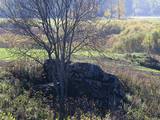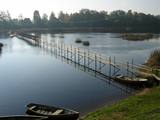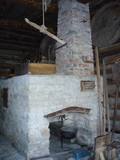| Нo | Название | Описание |
|---|---|---|
|
Уютный ресторан, повара которого черпают вдохновение в местном растительном и животном царстве, предлагая посетителям насладиться забытыми вкусами в любое время года. Почетное место здесь занимают как местные блюда, так и продукты от лучших мировых мастеров. Великолепное сочетание разных вкусов и вина делает Umb Roht рестораном, в котором можно отправиться в самые разнообразные вкусовые путешествия. |
||
|
Крупнейшая в Латвии страусиная ферма находится неподалеку от Кулдиги, здесь можно купить питательные и полезные для здоровья продукты из страусиного мяса, а также отправиться на экскурсию по страусиной и козьей ферме. Предлагаются услуги питания. |
||
|
Atrodas 200 m ziemeļaustrumos no akmens tilta pār Tebru. Ūdensdzirnavu komplekss celts 18. gs. beigās – 19. gs. sākumā uz Tebras upītes, uzpludinot Dzirnavdīķi. Blakus dzirnavām atrodas 19. gs. beigās celtā Aizputes muižas alusdarītava, apvienojot divas vecākas Pilsmuižas saimniecības ēkas. |
||
|
The word “Luitemaa” means “land of the dunes” in Estoninan. This coastline territory stretches for 13 km between Vöiste and Häädemeste with shallow waters, large coastal plains, Estonia’s highest dunes, and the Tokuse swamp (Tokuse raba). There are lots of birds here.
|
||
|
This tour can be done with your own or rented car and it includes driving, some hiking parts and transfers with the public transport. This grand Forest Trail and Baltic Coastal Hiking Route tour includes some of the best and most beautiful parts of the Forest Trail and Baltic Coastal Hiking Route in Lithuania and the southern part of Latvia. Hikes are combined with trips and excursions in cities, as well as other popular tourist sights in both countries. You will get a detailed impression about the forest diversity, coastal landscape and most popular national and regional nature parks in Latvia and Lithuania.
At the end of the tour you will go for a 1 day hike in Kurtuvėnai Regional Park which is one of the most forested areas in Central Lithuania with very pronounced glacier-shaped terrain forms spread in the Eastern Žemaitija Upland. |
||
|
Один из красивейших замков Латвии (стиль эклектизма), который хозяин замка Адольф фон Вульф подарил своей жене. По проекту архитектора Х. Гризенбаха он возводился в период с 1893 по 1896 гг. Рядом с замком на берегах речушки Сула раскинулся Цесвайнский парк, в котором находится поросшее лесом Цесвайнское городище. Завершены работы по реконструкции крыши Цесвайского замка! Замок открыт для посетителей с гидом из туристического центра. Звоните по телефону +371 26172637. Весной 2020 года строительные работы в замке будут продолжены, и замок может быть временно недоступен для посетителей. Информация об изменениях- www.cesvaine.lv |
||
|
От родного дома Атиса Кронвалда (1837 – 1875) – выдающегося латышского публициста, педагога и языковеда – «Леяс Мики» в Кроте Приекульского края ничего до сегодняшнего дня не сохранилось. На месте дома установлена мемориальная плита с надписью «Для каждого священно то место, где родился и вырос» (А. Кронвалдс). |
||
|
Ботанический сад является подразделением Шяуляйского университета. Это самый молодой и самый небольшой по площади ботанический сад в Литве. Сад был заложен в 1958 г. Его общая площадь составляет 6,54 га. |
||
|
Līdz 40m augsta ar mežu apaugusi Gaujas labā pamatkrasta nogāze ar vairākiem smilšakmens atsegumiem. Viens no tiem atrodas nogāzes lejasdaļā un veido 7m platu 5m dziļu nišu. Otrā krastā – vairākus metrus augstais Leimaņu iezis. Abi atsegumi atrodas aiz Amatas ietekas.
|
||
|
Пурмальский валун является одним из самых больших в
Резекненском крае и одним из двадцати больших в Латвии.
Находится в излучине на крутом склоне с деревьями и зарослями.
Камень был разрушен выломанными брешами, которые теперь образовали большие ступени. Камень
залег на крутом склоне, что еще больше увеличивает его пейзажность. Обхват его 18,5 м; высота 3,2
м; длина 5,6 м; ширина 4,7 м; объем над поверхностью земли около 30 куб.м.
|
||
|
Līdz 18. gs. šajā vietā bija koka baznīca, kamēr 1798. g. uzcēla mūra baznīcu, kas cieta 1. pasaules karā, bet 2. pasaules kara laikā to uzspridzināja. Tikai pusgadsimtu vēlāk - 1991. gadā tika uzsākti atjaunošanas darbi, kas joprojām turpinās. Tagad redzamais dievnams ir iepriekšējā līdzinieks. |
||
|
(1735 г.). Находится на левом берегу реки Вента за старинным кирпичным мостом по адресу ул. Пилс 4. Строительным материалом послужили камни от разрушенного герцогского дворца, а сам домик был построен на террасе, которая является последним сохранившимся фрагментом замковой стены. Сторожку (именуемую также Домик Палача) перестроили в 19 веке. Сторожку можно осмотреть снаружи. |
||
|
Хозяйка готовит сыры и мясные копчености. Принимают группы туристов и индивидуальных посетителей. Продукцию можно приобрести и в Риге. |
||
|
This is a route for hikers and bicyclists, starting at the village of Vaidava and then moving along the eastern shore of the narrow Lake Vaidava, which has steep cliffs around it. The trip covers the Veļķi baronial estate, the “Swedish pine”, the famous Vaidava (Metimne) hillfort, a series of streams, the great Rubene rock, the Vaidava baronial estate on the western shore of the lake. After that, the trail leads the visitor back to the starting point.
|
||
|
Based on the tower of a former Soviet army radar installation, there is an 18-metre viewing tower at the Southern breakwater of Ventspils (Medņu Street) today. The tower offers a good view of the port territory, with the sea gate at the mouth of the Venta River and the city beach. Binoculars are available at the tower. It is worth walking down the Southern breakwater to get a better look at the sea.
|
||
|
Одно из редких мест в мире, где по-прежнему в промышленном масштабе ловят миногу, используя старинный метод, которому более 150 лет – закол, т.е. через реку построены мостки с мережами. На Салаце таких три. В сопровождении местного рыбака можно увидеть процесс рыбной ловли, отведать и на месте приобрести жареную миногу. |
||
|
This grand hiking tour is provided for experienced hikers wishing to walk along a large part of the coasts of Latvia and Estonia, gain a detailed impression about the diverse coastal landscape, nature, birds and animals of the Baltic Sea. The Baltic Coastal Hiking Route sometimes runs through sandy beaches, sometimes along sections of beach covered in stones and pebbles. Sometimes the trail goes through coastal forests or stops at a fishermen’s village. There are many floodplain meadows, lagoons and shallow bays on the Estonian side, so sometimes the path goes along coastal trails and roads. In the end section of the route you will feel Estonia’s Nordic nature more. Part of the route runs along a sparsely populated seashore where you can be alone with yourself, but you will also be able to visit the most prominent cities. You will visit both capitals: Rīga and Tallinn. Enjoy the hospitality of the resort towns of Jūrmala, Pärnu and Haapsalu. During the hike, you will also get acquainted with the regions of small ethnic cultures: the Livonians in Latvia and the inhabitants of Kihnu in Estonia. |
||
|
Atrodas Valmieras – Ainažu autoceļa (P 16) malā starp Matīšiem un Aloju. Iekārtota vecajā un atjaunotajā dzirnavu ēkā. Nedēļas nogalēs piedāvā izklaides pasākumus, klāj galdus un īrē telpas svinībām. |
||
|
Das bekannteste Museum der Geschichte der Bienenzucht Litauens mit den Bienenhäusern verschidener Arte, der Arbeitsmittel der Bienenzüchter, Holzskulpturen und Hönigankauf. |
||
|
In Metsanurme Village Centre you can see restored old threshing barn, limestone barn oven and few tools that were used ages ago. You could be also interested in seeing an outdoor exhibition which focuses on historical agricultural tools. All of this is made to look interesting to not only locals but also visitors. |
||
























